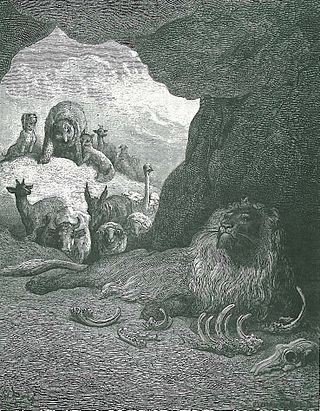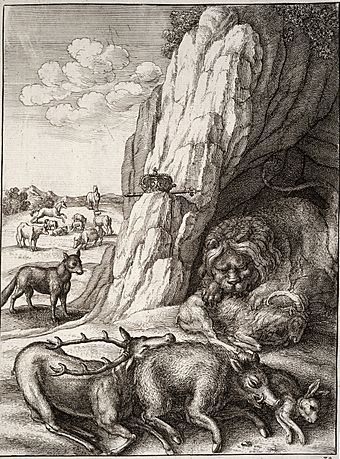The Fox and the Sick Lion facts for kids

The Fox and the Sick Lion is a famous story from Aesop's Fables. It is known as Fable 142 in the Perry Index. There is also a similar story from India. People have thought about what this story means for over 2,500 years.
Contents
The Story's Beginnings
A lion grew old and too weak to hunt for food. He pretended to be sick to trick other animals. When animals came to visit him in his cave, he ate them. But the clever fox only greeted the lion from outside. When the lion asked why the fox did not come in, the fox replied, "Because I can only see footprints going into your cave, but none coming out!"
Ancient Lessons from the Fable
This fable was first used to talk about money and trade. This was in a book called First Alcibiades, possibly written by Plato around 400 BCE. In this book, Socrates talks about the economy of Sparta. He says that Sparta had a lot of gold and silver coming in, but none leaving. He compared this to the fox's words to the lion: "The footprints of those going in are clear enough, but who ever saw the trace of money going out of Lacedaemon?"
The Roman poet Horace also mentioned this fable. He used it to teach that once you get involved in bad habits, it's hard to stop. He wrote about Roman bankers who wanted to get rich quickly. He said he was like the fox, cautious of where the tracks led.
There is a similar story in India called the Nalapana Jataka. In this tale, a monkey king saves his group from a water-ogre. He checks a jungle pool and sees that all the footprints go into the water, but none come back out.
Why Be Cautious?
In the Middle Ages, people used this fable to teach important lessons. Writers like Adémar de Chabannes and Romulus Anglicus said we should learn from what happens to others. They also added a political idea: "It is easier to enter the house of a great lord than to get out of it." William Caxton wrote this in his English version.
However, Hieronymus Osius focused on being wise. He said a smart person not only sees signs of danger but also learns to be careful from them. Gilles Corrozet also used the fable to show the need to be careful in everything you do. He said you should always think about what you might gain or lose.
Caution About Rulers
During the 1600s, the fable was often seen as a warning about powerful rulers. Wenceslas Hollar showed this in his pictures for The Fables of Aesop (1673). His drawing shows a crown and scepter near the cave. This suggests the lion represents a king.
Pieter de la Court also made this point in his book Sinryke Fabulen (1685). He wrote, "An old courtier, an old survivor." This means someone who has been around powerful people for a long time knows how to stay safe. He also added a Latin saying: "With princes as with fire, be wary." This means you should be careful around powerful people, just like you are careful around fire.
Trusting Others' Words
In Jean de La Fontaine's Fables, the story adds more details about kings. The lion gives a "safe conduct" pass to the animals. This pass is supposed to protect them. But the foxes send a note back saying, "While seeing how the beasts get in, we do not see how they get out." This means you cannot always trust what powerful people say.
Roger L’Estrange's version in 1692 also talks about notes between the fox and lion. He added that you should think carefully about the kindness of people who are mean or have bad plans.
Using Your Reason
Later, people said the fable teaches us to use our brains to avoid trouble. Samuel Croxall wrote in 1722 that we should act like reasonable people. We should do as few things as possible that we might regret later.
Thomas Bewick in 1818 went even further. He said that people should not just believe things because they were born in a certain place. He believed you should think for yourself and decide what you believe.
External Links
- 15th-20th century illustrations from books


